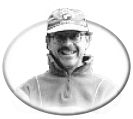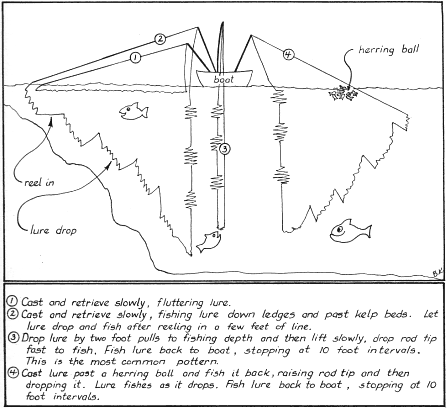
Drift Fishing - Part Two
with
D.C. Reid
illustrations by Barb Krimmer
Now that you’ve picked up the basic drift fishing gear - a 7 - 8foot rod with semi-stiff tip, a single action reel with 300 yards of 25pound test and an array of sexy lures - you want to get out there and fish.The question that leaps to your mind is: where? You ask this question becauseyou have read the trolling sections of this web-page and realize the oceanis a huge place with small sprinklings of salmon in vast amounts of emptyspace.
So where and when does drift fishing hit its peak? Let’s answerthe second question first. Drift fishing proves most solid in summer - Julyto October - when as many as five species may be present on any given day,and possibly vying for the same, limited food supply. As lures representwounded baitfish, your targets are the carnivores of the salmonid family:chinook, coho, and pink. (Sockeye and chum will bite a lure out of hormonalirritation, but, as plankton feeders, not very often for other reasons.)Winter drift fishing usually proves successful in locations where fish canbe bunched by land contours.
Two locations suggest themselves: where the bait is and where the fishare. Bait can usually be found in tidelines from 1 to 3 miles offshore orassociated with some land structure. Bait gets pushed into tidelines andsalmon, usually coho and pink, follow. Normally summer fishing of this typeoccurs within 50 feet of the surface. The key is to find herring balls,those masses of silver flesh attacked from below by salmon and from aboveby squawking seagulls. Drift fishers are well advised to follow herringball activity around the fishing ground, quietly approaching the ball andfishing to the side or underneath the school. Keep an eye open for herringscales in the water. Quite often, salmon will lie out of sight 30 to 40feet beneath them for some time.
Alternatively, find bait schools associated with land structures. Findareas of restricted tidal flow, entrances or exits to small passes, backeddiesbehind islands, spires of rock that rise from deeper waters, shoreline nooksand crannies at the crack of dawn when chinook and bait can be within astone’s throw from land, mud-covered bottoms where needlefish feed,and bait shoals on depthsounders. Areas that combine rugged underwater terrainwith street lights can be deadly, even in the middle of the night, as herringspritz from the water as though shot from cannons, escaping the wily salmon.
Drift fishing technique is so deceptively simple that it is, well, simple;however, incorrectly performed, nothing will be achieved. Strip off linefrom the reel in two feet "pulls". The purpose is to know exactlyhow deep the lure is so that after receiving a strike you can immediatelyzero in on the fishy zone. Drift fishers methodically cover the depths between20 and 120 feet, stopping every ten feet to fish for a few minutes. Dueto their facial features, salmon see forward and slightly up and are longconditioned to feeding on bait from underneath. Accordingly it’s bestto fish a bit shallower than deeper.
The slow up fast down rod technique has already been suggested. Bearin mind that the lure fishes only on the downward flutter, ie., during therest of cycle the lure might as well be a tennis shoe for all the food synapsesit fires in a salmon’s fingertip-sized brain. Do not, however, yankthe rod up fast. This can pull the lure completely out of view of the salmonor make it move so rapidly that it is pulled repeatedly out of the way ofa charging salmon. The correct pattern is: slow up, fast down.
Add some variation to your pattern: a six foot pull followed by a fewflutters, then a two or three two foot pull, and so on. Make it appear thatthe lure is in trouble, but trying to right itself and get away. Most predatorsrespond swiftly to food that appears to be making a get away. Make sureto fish your lure back to the boat, stopping every ten feet or so. Manyfish follow lures up and strike within view of the boat. Be sure to coverall the water around the boat, as well as fishing lures up or down underwatershelves. Refer to the diagram for fishing patterns.

Once a fish has bitten, setting hooks is crucial in drift fishing. Trolledlures tend to set themselves because the fish turns away from an essentiallyfixed lure. During drift fishing, lures usually receive bites while thelure is falling and there is slack between it and the rod. The salmon canpick the lure up and carry it without coming in contact with the hook. Thebite can be so dramatic that it takes you by surprise or so soft that youdon’t know it has happened. My favourite drift fishing bite is whenthe lure does not reach the bottom of its fall and a curl of line floatson the surface. Ah the glee, the adrenaline rush!
Regardless of bite variety, get in the habit of pulling up hard whenany bump, nudge or tick is felt. Hold the forefinger of your rod hand aroundthe line at all times to provide added drag. If you are fortunate enoughto have the time, point the rod tip at the water and reel in like crazy.In the same instant, pull that rod up as high as you can. Salmon have bonyjaws and it takes good strength to secure the hook in the scant flesh ofthe mouth or throat. It is easy to understand why hooks should be sharpenedeach time out. Drape each point on your thumb nail. Only hooks that digin and hold are sharp enough.
Sometimes, no matter how skilled the fisher, hooks just refuse to set.In these circumstances, alter your technique: resharpen all hooks; use astiffer-tipped rod or restring the mainline through the second rod guide;lower the rod tip only a bit faster than the lure drops; mount hooks onboth ends of the lure; or, move from a treble to a single hook.
Sooner or later the gods of fishing fish will be moved by your efforts.Then the fight will be on. Imagine yourself in the late afternoon sun, utterquiet and then the reel screeching. Even the water will stop to listen.Best of luck.
|




